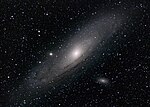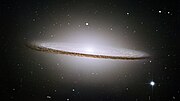clustered nature of star formation by treating star clusters as the fundamental unit of star formation. This approach permits the growth of star particles by... 45 KB (5,608 words) - 07:05, 7 April 2024 |
 | formation process. The observation of binaries consisting of stars not yet on the main sequence supports the theory that binaries develop during star... 68 KB (8,144 words) - 11:36, 18 April 2024 |
 | Nebular hypothesis (redirect from Planet formation) not well known. Thus the formation of planetary systems is thought to be a natural result of star formation. A Sun-like star usually takes approximately... 75 KB (9,132 words) - 21:19, 18 March 2024 |
 | Molecular cloud (section Star Formation) (if star formation is occurring within), is a type of interstellar cloud, the density and size of which permit absorption nebulae, the formation of molecules... 33 KB (3,729 words) - 09:11, 1 April 2024 |
 | Elliptical galaxy (section Star formation) clusters. Star formation activity in elliptical galaxies is typically minimal; they may, however, undergo brief periods of star formation when merging... 17 KB (1,890 words) - 20:22, 16 April 2024 |
 | Galaxy (section Formation and evolution) heavy elements, eventually allowing the formation of planets. Hubble eXtreme Deep Field (XDF) Star formation rates in galaxies depend upon their local... 164 KB (16,377 words) - 17:18, 27 April 2024 |
 | Cosmology (redirect from Bursty star formation) cosmological constant. Absolute time and space Big History Earth science Galaxy formation and evolution Illustris project Jainism and non-creationism Lambda-CDM... 51 KB (3,263 words) - 19:20, 24 April 2024 |
 | Leo I (dwarf galaxy) (section Star formation) major increase (accounting for 70% to 80% of its population) in its star formation rate between 6 Ga and 2 Ga (billion years ago). There is no significant... 8 KB (891 words) - 22:23, 2 December 2023 |
 | Starburst galaxy (redirect from Star burst galaxies) exceptionally high rate of star formation, as compared to the long-term average rate of star formation in the galaxy, or the star formation rate observed in most... 19 KB (2,046 words) - 05:47, 11 March 2024 |
 | Triangulum Galaxy (section Star formation) "The Star Formation History of the Local Group". In F. Favata; A. Kaas; A. Wilson (eds.). Proceedings of the 33rd ESLAB symposium on star formation from... 48 KB (5,110 words) - 05:08, 26 April 2024 |
 | parent star Kepler 452 7.98 billion years (5.82 Gya): Formation of Mira or Omicron ceti, binary star system. Formation of Alpha Centauri Star System,... 36 KB (4,978 words) - 09:10, 17 April 2024 |
 | Messier 100 (section Star formation) spots. Messier 100 is considered a starburst galaxy with the strongest star formation activity concentrated in its center, within a ring – actually two tightly... 10 KB (1,085 words) - 09:17, 24 February 2024 |
 | Whirlpool Galaxy (section Star formation) period of enhanced star formation. The present efficiency of star formation, defined as the ratio of mass of new stars to the mass of star-forming gas, is... 29 KB (2,982 words) - 23:59, 12 March 2024 |
 | Andromeda Galaxy (section Formation and history) sequence" (galaxies that lack star formation). Star formation activity in green valley galaxies is slowing as they run out of star-forming gas in the interstellar... 108 KB (10,628 words) - 03:57, 22 April 2024 |
 | small dark nebulae containing dense cosmic dust and gas from which star formation may take place. Bok globules are found within H II regions, and typically... 9 KB (842 words) - 09:43, 4 March 2024 |
 | Stellar population (redirect from Population III star) were later shown to be very important and were possibly related to star formation, observed kinematics, stellar age, and even galaxy evolution in both... 35 KB (3,671 words) - 15:55, 29 April 2024 |
baryonic physics, gas heating and cooling, star formation and feedback. Understanding the processes of galaxy formation is a major topic of modern cosmology... 27 KB (3,468 words) - 09:11, 2 June 2023 |
 | Nebula (redirect from Nebulous star) Nebulae are often star-forming regions, such as in the "Pillars of Creation" in the Eagle Nebula. In these regions, the formations of gas, dust, and other... 21 KB (2,844 words) - 07:15, 13 April 2024 |
 | Spiral galaxy (redirect from Halo star) center into the galactic disc. The spiral arms are sites of ongoing star formation and are brighter than the surrounding disc because of the young, hot... 30 KB (3,619 words) - 14:09, 19 April 2024 |
 | Local Bubble (section Impact on star formation) for the formation of all young, nearby stars. These new stars are typically in molecular clouds like the Taurus molecular cloud and the open star cluster... 20 KB (2,080 words) - 10:01, 26 January 2024 |
 | Open cluster (redirect from Cluster formation) have been found only in spiral and irregular galaxies, in which active star formation is occurring. Young open clusters may be contained within the molecular... 51 KB (6,248 words) - 01:28, 6 February 2024 |
 | Messier 65 (section Star formation) of authors. The galaxy is low in dust and gas, and there is little star formation in it, although there has been some relatively recently in the arms... 6 KB (491 words) - 06:59, 30 December 2023 |
 | (25 May 2013). "Massive black hole factories: Supermassive and quasi-star formation in primordial halos". Astronomy & Astrophysics. 558: A59. arXiv:1305... 9 KB (1,048 words) - 10:20, 18 April 2024 |







